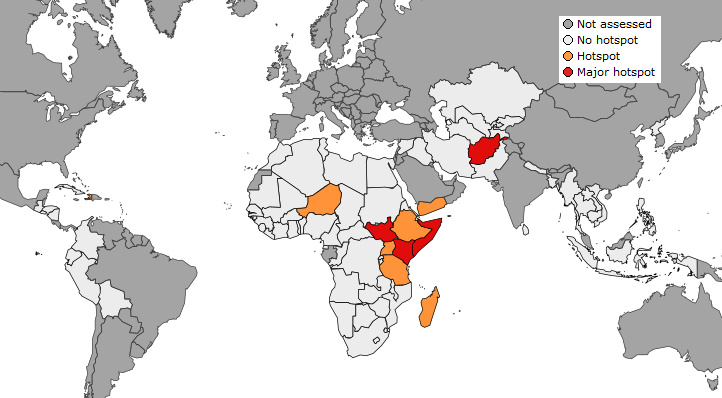
ASAP hotspot assessment November 2021
© European Union, 2021
The November edition of the JRC's Anomaly Hotspots of Agricultural Production (ASAP) assessment is now available at:
Main findings of the November global overview
- In Southern Africa, generally favourable weather conditions are benefiting early vegetative stages of summer cereal crops. Below-average biomass conditions are observed in southern Angola and in most of Madagascar, and the situation should be closely monitored in the coming weeks.
- In East Africa, drought conditions continue to worsen affecting in particular the southern and eastern parts of Ethiopia, most of Somalia, southern, coastal and central Kenya and north-eastern Tanzania. At this stage of the season, cumulated rainfall recovery is very unlikely increasing the risk of agricultural production failure. The food security situation in South Sudan, in the Tigray, western Afar and northern Amhara regions of Ethiopia is alarming.
- In West and Central Africa, the main season is complete and cereal production is expected to be ca. 7% below the 5-year average for the Sahel and similar or slightly above the 5-year average for the Gulf of Guinea (PREGEC Communique). Reduced outputs are expected in the conflict-affected parts of the region. Second season maize in the Gulf of Guinea is progressing well.
- In North Africa and the Middle East, the onset of the winter cereal season is characterised by late onset and drier than average conditions. It is still early in the season and there is room for improvement, however monitoring of the situation in the coming weeks is crucial. For North Africa the Copernicus C3S multi-model seasonal rainfall forecast and for the Middle East the rainfall forecast by WMO indicate a high probability of below-average rainfall.
- In Central Asia, winter crops have been sown under below-average rainfall conditions. In Afghanistan, only 50% of the usual area has been sown with winter wheat due to below-average rainfall in October and November and poor socio economic conditions. In South Asia, harvest of kharif crops and Aman rice is underway with good prospects, while sowings of Rabi wheat and Boro rice have started in Pakistan and Bangladesh, respectively. Plantings of main season rice in Sri Lanka have started with above-average rainfall.
- In South-East Asia, the wet season rice harvest is ongoing (or finishing in Cambodia), with good prospects and planting of dry season rice has started under favourable conditions. In Indonesia, prospects are also favourable for the ongoing harvest of dry season rice.
- In Central America, negative water crop balance prevailed, particularly for north-eastern Honduras and Nicaragua, central Guatemala and most of Haiti. As a result, the postrera maize and beans yields have been affected in parts of the region. The lingering effects of prior natural disasters and economic shocks are slowing recovery of households’ food security in Central America and Haiti.
The next assessment is scheduled for the end of January 2022.
Related Content
Anomaly Hotspots of Agricultural Production (ASAP) assessment
Details
- Publication date
- 9 December 2021
